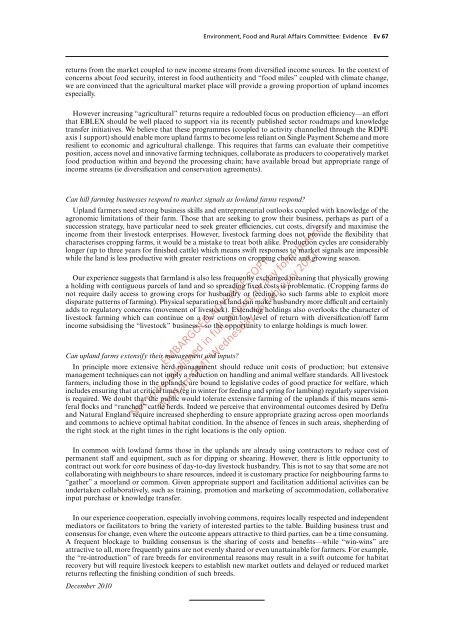Farming in the Uplands - ARCHIVE: Defra
Farming in the Uplands - ARCHIVE: Defra
Farming in the Uplands - ARCHIVE: Defra
Create successful ePaper yourself
Turn your PDF publications into a flip-book with our unique Google optimized e-Paper software.
Environment, Food and Rural Affairs Committee: Evidence Ev 67<br />
returns from <strong>the</strong> market coupled to new <strong>in</strong>come streams from diversified <strong>in</strong>come sources. In <strong>the</strong> context of<br />
concerns about food security, <strong>in</strong>terest <strong>in</strong> food au<strong>the</strong>nticity and “food miles” coupled with climate change,<br />
we are conv<strong>in</strong>ced that <strong>the</strong> agricultural market place will provide a grow<strong>in</strong>g proportion of upland <strong>in</strong>comes<br />
especially.<br />
However <strong>in</strong>creas<strong>in</strong>g “agricultural” returns require a redoubled focus on production eYciency—an eVort<br />
that EBLEX should be well placed to support via its recently published sector roadmaps and knowledge<br />
transfer <strong>in</strong>itiatives. We believe that <strong>the</strong>se programmes (coupled to activity channelled through <strong>the</strong> RDPE<br />
axis 1 support) should enable more upland farms to become less reliant on S<strong>in</strong>gle Payment Scheme and more<br />
resilient to economic and agricultural challenge. This requires that farms can evaluate <strong>the</strong>ir competitive<br />
position, access novel and <strong>in</strong>novative farm<strong>in</strong>g techniques, collaborate as producers to cooperatively market<br />
food production with<strong>in</strong> and beyond <strong>the</strong> process<strong>in</strong>g cha<strong>in</strong>; have available broad but appropriate range of<br />
<strong>in</strong>come streams (ie diversification and conservation agreements).<br />
Can hill farm<strong>in</strong>g bus<strong>in</strong>esses respond to market signals as lowland farms respond?<br />
Upland farmers need strong bus<strong>in</strong>ess skills and entrepreneurial outlooks coupled with knowledge of <strong>the</strong><br />
agronomic limitations of <strong>the</strong>ir farm. Those that are seek<strong>in</strong>g to grow <strong>the</strong>ir bus<strong>in</strong>ess, perhaps as part of a<br />
succession strategy, have particular need to seek greater eYciencies, cut costs, diversify and maximise <strong>the</strong><br />
<strong>in</strong>come from <strong>the</strong>ir livestock enterprises. However, livestock farm<strong>in</strong>g does not provide <strong>the</strong> flexibility that<br />
characterises cropp<strong>in</strong>g farms, it would be a mistake to treat both alike. Production cycles are considerably<br />
longer (up to three years for f<strong>in</strong>ished cattle) which means swift responses to market signals are impossible<br />
while <strong>the</strong> land is less productive with greater restrictions on cropp<strong>in</strong>g choice and grow<strong>in</strong>g season.<br />
Our experience suggests that farmland is also less frequently exchanged mean<strong>in</strong>g that physically grow<strong>in</strong>g<br />
a hold<strong>in</strong>g with contiguous parcels of land and so spread<strong>in</strong>g fixed costs is problematic. (Cropp<strong>in</strong>g farms do<br />
not require daily access to grow<strong>in</strong>g crops for husbandry or feed<strong>in</strong>g, so such farms able to exploit more<br />
disparate patterns of farm<strong>in</strong>g). Physical separation of land can make husbandry more diYcult and certa<strong>in</strong>ly<br />
adds to regulatory concerns (movement of livestock). Extend<strong>in</strong>g hold<strong>in</strong>gs also overlooks <strong>the</strong> character of<br />
livestock farm<strong>in</strong>g which can cont<strong>in</strong>ue on a low output/low level of return with diversification/oV farm<br />
<strong>in</strong>come subsidis<strong>in</strong>g <strong>the</strong> “livestock” bus<strong>in</strong>ess—so <strong>the</strong> opportunity to enlarge hold<strong>in</strong>gs is much lower.<br />
Can upland farms extensify <strong>the</strong>ir management and <strong>in</strong>puts?<br />
In pr<strong>in</strong>ciple more extensive herd management should reduce unit costs of production; but extensive<br />
management techniques can not imply a reduction on handl<strong>in</strong>g and animal welfare standards. All livestock<br />
farmers, <strong>in</strong>clud<strong>in</strong>g those <strong>in</strong> <strong>the</strong> uplands, are bound to legislative codes of good practice for welfare, which<br />
<strong>in</strong>cludes ensur<strong>in</strong>g that at critical times (eg <strong>in</strong> w<strong>in</strong>ter for feed<strong>in</strong>g and spr<strong>in</strong>g for lamb<strong>in</strong>g) regularly supervision<br />
is required. We doubt that <strong>the</strong> public would tolerate extensive farm<strong>in</strong>g of <strong>the</strong> uplands if this means semiferal<br />
flocks and “ranched” cattle herds. Indeed we perceive that environmental outcomes desired by <strong>Defra</strong><br />
and Natural England require <strong>in</strong>creased shepherd<strong>in</strong>g to ensure appropriate graz<strong>in</strong>g across open moorlands<br />
and commons to achieve optimal habitat condition. In <strong>the</strong> absence of fences <strong>in</strong> such areas, shepherd<strong>in</strong>g of<br />
<strong>the</strong> right stock at <strong>the</strong> right times <strong>in</strong> <strong>the</strong> right locations is <strong>the</strong> only option.<br />
EMBARGOED ADVANCE COPY:<br />
Not to be published <strong>in</strong> full, or part, <strong>in</strong> any form before<br />
00.01am GMT Wednesday 16 February 2011<br />
In common with lowland farms those <strong>in</strong> <strong>the</strong> uplands are already us<strong>in</strong>g contractors to reduce cost of<br />
permanent staV and equipment, such as for dipp<strong>in</strong>g or shear<strong>in</strong>g. However, <strong>the</strong>re is little opportunity to<br />
contract out work for core bus<strong>in</strong>ess of day-to-day livestock husbandry. This is not to say that some are not<br />
collaborat<strong>in</strong>g with neighbours to share resources, <strong>in</strong>deed it is customary practice for neighbour<strong>in</strong>g farms to<br />
“ga<strong>the</strong>r” a moorland or common. Given appropriate support and facilitation additional activities can be<br />
undertaken collaboratively, such as tra<strong>in</strong><strong>in</strong>g, promotion and market<strong>in</strong>g of accommodation, collaborative<br />
<strong>in</strong>put purchase or knowledge transfer.<br />
In our experience cooperation, especially <strong>in</strong>volv<strong>in</strong>g commons, requires locally respected and <strong>in</strong>dependent<br />
mediators or facilitators to br<strong>in</strong>g <strong>the</strong> variety of <strong>in</strong>terested parties to <strong>the</strong> table. Build<strong>in</strong>g bus<strong>in</strong>ess trust and<br />
consensus for change, even where <strong>the</strong> outcome appears attractive to third parties, can be a time consum<strong>in</strong>g.<br />
A frequent blockage to build<strong>in</strong>g consensus is <strong>the</strong> shar<strong>in</strong>g of costs and benefits—while “w<strong>in</strong>-w<strong>in</strong>s” are<br />
attractive to all, more frequently ga<strong>in</strong>s are not evenly shared or even unatta<strong>in</strong>able for farmers. For example,<br />
<strong>the</strong> “re-<strong>in</strong>troduction” of rare breeds for environmental reasons may result <strong>in</strong> a swift outcome for habitat<br />
recovery but will require livestock keepers to establish new market outlets and delayed or reduced market<br />
returns reflect<strong>in</strong>g <strong>the</strong> f<strong>in</strong>ish<strong>in</strong>g condition of such breeds.<br />
December 2010

















